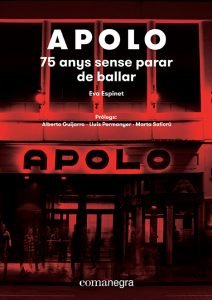[dropcap letter=”T”]
all, muscular, sure of himself, the young Johnny, dressed in his neat sailor suit, enters the red door of the Baile Apolo (Apolo Dance Club) to do his best on the dance floor and, who knows, perhaps dance with the most beautiful girl around. Other comrades have told him that there are some taxi-girls dancing devilishly well. Johnny have been given permission to attend the party that, for two days, is held at the Apolo Dancing Saloon Barcelona, and attended by hundreds of sailors of the VI American Fleet, whose ships have been docked for two summers in the port of Barcelona.
 Today, September 8th, 1953, they celebrate the end of the war between the United States and Korea. There will be a nice supper, whiskey will be served generously and the frantic rhythm of a young and almost unknown singer, called Elvis Presley, will seize the hips of these guys who are willing to forget for a few hours why they are so far from their homes and their families. From the dance floor of Baile Apolo, a thunderous rhythm descends to the entrance, electrifying Johnny’s senses, who is now accompanied by two friends he has met at the lobby bar. He has been told that the popular Apolo Orchestra performs, along with the two bands that entertain the troops with the hottest jazz and rock & roll, two musical genres that are barely heard in post-war Spain. The young sailor rides the wooden steps illuminated by a candelabra that guides him to hell itself, a dance floor that seems to burn by the intensity of the dance…
Today, September 8th, 1953, they celebrate the end of the war between the United States and Korea. There will be a nice supper, whiskey will be served generously and the frantic rhythm of a young and almost unknown singer, called Elvis Presley, will seize the hips of these guys who are willing to forget for a few hours why they are so far from their homes and their families. From the dance floor of Baile Apolo, a thunderous rhythm descends to the entrance, electrifying Johnny’s senses, who is now accompanied by two friends he has met at the lobby bar. He has been told that the popular Apolo Orchestra performs, along with the two bands that entertain the troops with the hottest jazz and rock & roll, two musical genres that are barely heard in post-war Spain. The young sailor rides the wooden steps illuminated by a candelabra that guides him to hell itself, a dance floor that seems to burn by the intensity of the dance…
This could be the story of one among those hundreds of young US soldiers who were seen at the popular nightclub Baile Apolo. “The hall will be filled, to the point that it will hard to walk, with well-dressed sailors and dozens of young women eager to find a man with a future, who will take them to the floor to dance and perhaps, in the near future, give them a better life in Spain or on the other side of the ocean, anything to get out of the horror of the post-war period. A band of sailors play music, a music that makes girls fly acrobatically, following the “leaders” who carry them around the dance floor. The rhythm is wild, and the atmosphere gets hot. Some take the opportunity to seduce their girl in the darkest corners of the upper gallery. The free drinks offered by the Americans help to disinhibit the bodies…”, this is how one of the stories that has made the myth of Barcelona’s most iconic dance floor, the Sala Apolo, is related.
Before opening its doors as a party hall in 1943, it was one of the most unique amusement parks in Europe: by the end of 1935, a dragon’s mouth with sharp teeth swallowed the wagons with passengers, hysterical and frightened, that were literally engulfed into an underworld of demons, skulls, naked sirens and terrifying mummies
Apolo: 75 anys sense parar de ballar (“Apolo, 75 year of non-stop dancing”) is the book edited by Comanegra with which the 75th anniversary of the party hall is commemorated. It reveals the untold story of the Sala Apolo narrated by its protagonists, from workers of the club to artists, DJs, producers and clients, who have lived nights in which much of what was experienced was forgotten after a hangover or blurred by the sensual spirit of the times. “Everything changes. Nothing changes”, says the motto of the anniversary, because the night is equally dark for all, whatever is the time one has lived. At the Sala Apolo the hottest rhythms and the most rogue parties have worn the dancefloor and the protagonists enjoyed in the warmth of a vermilion luminescence and the red tones of its walls, sweating under the bits of night. The Bots parties, gypsy weddings, the hot Dominican rhythms of the 80’s that today would look naïve the reggaeton ‘perreos’, the electronics of the Nitsa, the Mondays of the Nasty Mondays, the trap, the dances with a lot of swing, the nights of burlesque or the wilderness of the parties Churros con Chocolate, concerts…

The pages of this book speak about the night, about leisure, about a city that does not sleep, that has fun, and pays tribute to this mythical room that was also – before opening its doors, as a party hall, in 1943- one of the most unique amusement parks in Europe. Let’s travel to the past, to the year 1935: a dragon’s mouth with sharp teeth swallows wagons with passengers, hysterical and frightened, that are literally engulfed into an underworld of demons, skulls, naked sirens and terrifying mummies. “The most original attractions of the city became the benchmark of leisure in an avenue of circuses, theatres and cabarets”, explains the book about Apolo. All this was possible thanks to a visionary of that time, José Vallés, who imagined an unsurpassed world of leisure, in the most vibrant avenue in the city, the Parallel.
Apolo is a ship full of surprises and, in the 50s, in a glorious time of attractions and dancing, the Apolo Skate Club becomes also famous for its Rollerblade Hockey competition. First Division games took place on the terrace, where there was an official court with a grandstand for five hundred people, a space that today is the ceiling of Room #3. A decade later, a ring entertained with its boxing matinees on post-war grey Sundays. And, why not, Apolo also dared to open its doors to the fashion game of the 70s, Bingo, one of the first in the city. In the 90s another visionary entered the play: Alberto Guijarro would recover Apolo’s aesthetic essence, turning the place into a club of clubs. Until current times, any sound novelty is possible in a scenario that always surprises. While the city sleeps, Apolo’s night goes on, non-stop dancing. Long live Apolo!




















